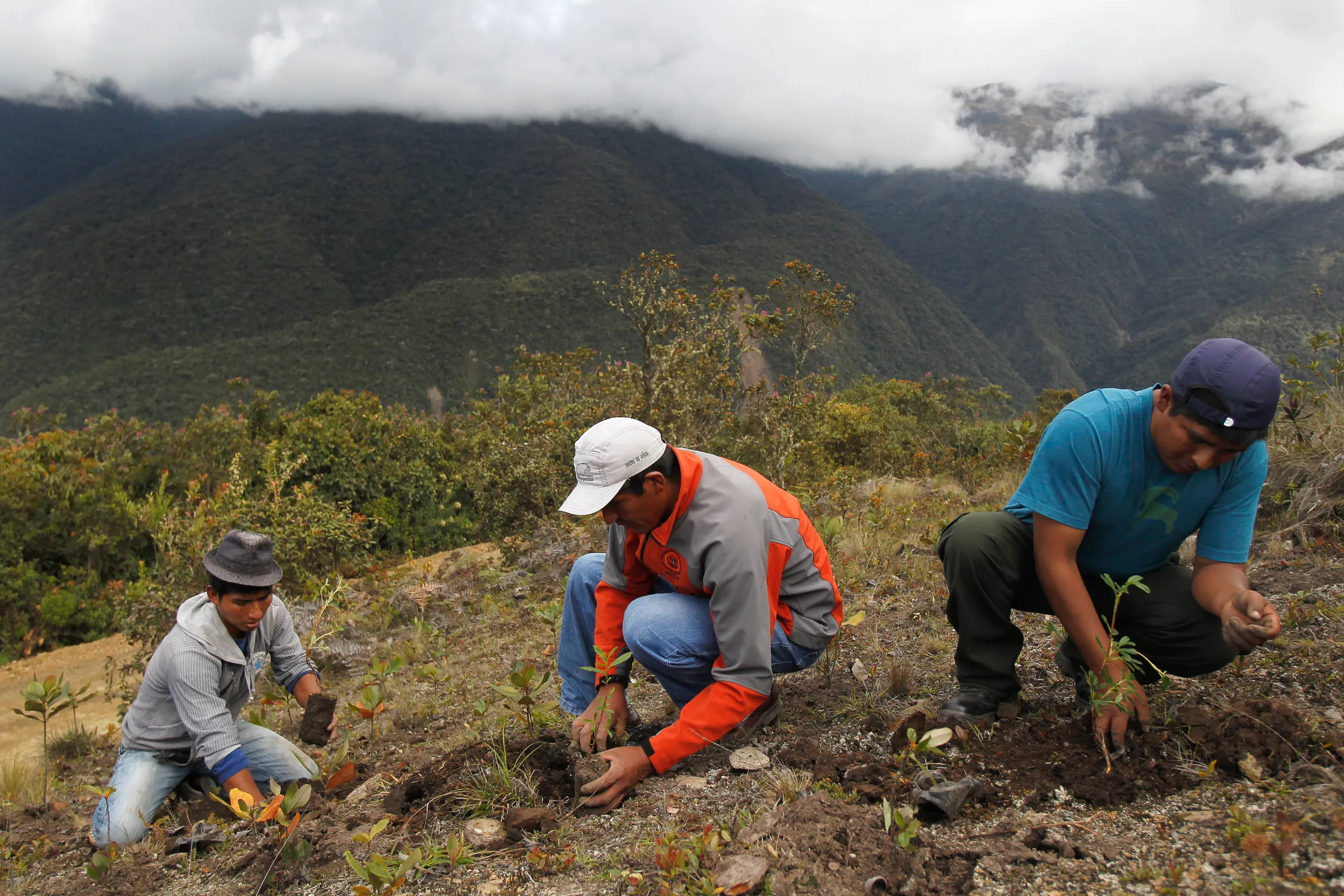USAID cuts threaten Amazon forest and fuel drug trade concerns

Workers plant seedlings for reforestation at Huayquecha Biological Station near Paucartambo, Cusco December 5, 2014. REUTERS/Enrique Castro-Mendivil
What’s the context?
With cuts in U.S. funding, Indigenous-led efforts to protect the Amazon forest are in limbo.
- U.S. foreign aid cuts freeze conservation projects
- Amazon communities lose support to fight deforestation
- Surveillance of coca plant farm expansion weakened
RIO DE JANEIRO - Peruvian Indigenous leader Francisco Hernández Cayetano travelled hundreds of miles along the Amazon river basin this month to tell communities working for a decade on a project to protect the forest there was no money left.
The initiative is one of hundreds of conservation projects put in limbo by a Jan. 20 executive order signed by U.S. President Donald Trump that froze billions of dollars in foreign aid for 90 days.
"There is a tremendous question mark in every community. We are giving free rein to illegal loggers, to coca plant growers", said Cayetano, president of the Federation of Ticuna and Yagua Communities of the Lower Amazon river.
Peru and Colombia are the world's biggest producers of coca, the raw ingredient for cocaine. Clearing trees to make way for coca fields is a key driver of Amazon forest destruction.

A member of Peru's special Army force stand guard on a landing strip used by drug trafficking aircrafts, before its detonation near the Ene river in Pangoa district, Ayacucho, September 11, 2014 REUTERS/Enrique Castro-Mendivil
A member of Peru's special Army force stand guard on a landing strip used by drug trafficking aircrafts, before its detonation near the Ene river in Pangoa district, Ayacucho, September 11, 2014 REUTERS/Enrique Castro-Mendivil
Indigenous groups fear their nature and sustainable business projects will end for good as the U.S. Agency for International Development (USAID) is gutted, raising concerns for hard-fought conservation gains and Indigenous governance.
The USAID-funded project enabled the Ticuna and Yagua communities to respond to satellite-generated deforestation alerts through an app and so helped the longstanding U.S. goal of fighting cocaine production and trafficking in Latin America.
Research published in 2021 in the PNAS journal suggested the initiative had succeeded in stemming deforestation, leading to an estimated 37% reduction in tree cover loss in two years compared to areas not covered by the project.
A U.S. judge on Feb. 13 ordered the government to restore payments to foreign aid partners, but it is still not clear whether the Trump administration will comply and for how long.
Tasked with the mission of slimming down the government, Trump's billionaire ally Elon Musk, has criticised USAID and said it was "time for it to die".
Even if funds and jobs are restored and protected by courts, damage has already been done, said an USAID employee who did not wish to have their name disclosed for fear of reprisals.
"People are returning to the USA from missions, data and archives have been deleted, so much aid has been lost already", they said.
As Ticuna and Yagua forest protectors returned the smartphones used to track deforestation in Peru's Amazon, Cayetano told them the local USAID-funded projects should be on hold for at least two or three months.
Near Peru's border with Colombia and Brazil, the agency had also been funding initiatives to substitute coca crops with cacao trees.
Earlier this month, gold prices reached a record high, adding to pressure facing the Amazon from illegal gold mining, deeply connected with drug trafficking in the region.
Colombia and Peru are the world's largest cocaine producers, data from the United Nations Office on Drug and Crime (UNODC) shows, and U.S. government data shows they are also South America's top recipients of USAID funds, largely linked to Washington's efforts to tackle drugs trafficking.
Conservation and humanitarian activities supported by USAID in the region were aligned with U.S. interests to stem the flow of cocaine to its citizens, said Ricardo Soberón, former head of Peru's DEVIDA drug policy agency.
Soberón said that on their own, efforts to investigate drug cartels and destroy coca crops, also supported by the United States, had not succeeded as planters "immediately get new seeds and move deeper into the forests".
The problem with such measures, he said, is that alone they do not "attack the socio-economic causes that give origin to deforestation" for coca leaf production.
Sustainable businesses
In 2024, Brazil, home to about 60% of the Amazon forest, was assigned $15 million from USAID funds for environmental initiatives such as training fire brigades, promoting sustainable businesses and strengthening Amazon organisations.
The Roraima Indigenous Council, for example, supports about 65,000 Indigenous people in the northern Amazon, and was planning to use USAID funds to structure 18 sustainable business projects, such as fish farming and production of folk crafts.
Its coordinator Edinho Macuxi said the institution was now looking for ways to pay its personnel, and that without strengthening communities to protect their lands the climate crisis would accelerate.
"With all that's been happening these days - climate change, floods, hot sun, diseases - it isn't only Indigenous people that are going to die," he said.
Brent Sohngen, environmental and resource economics professor at Ohio State University, said one example of a successful USAID-funded partnership had been establishing a sustainable timber businesses in Guatemala's Maya forest.
According to Sohngen, who co-authored two papers on the initiative, it helped protect both nature and the pre-Columbian ruins under the forest.
He said fostering sustainable businesses enabled communities to thrive where they live, and so helped stem the flow of migrants to the United States, one of USAID's goals and a priority of the Trump administration.
"Ultimately, people don't want to leave their land", Sohngen said.
(Reporting by Andre Cabette Fabio; Editing by Jack Graham and Jon Hemming.)
Context is powered by the Thomson Reuters Foundation Newsroom.
Our Standards: Thomson Reuters Trust Principles
Tags
- Adaptation
- Government aid
- Forests
- Biodiversity


















